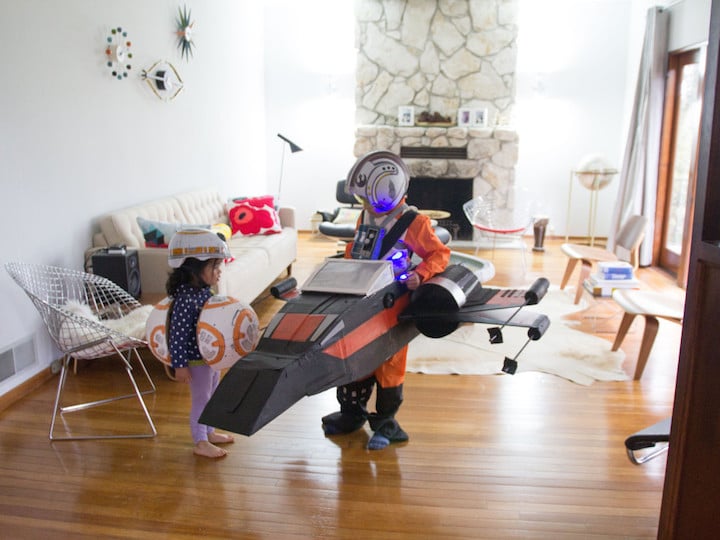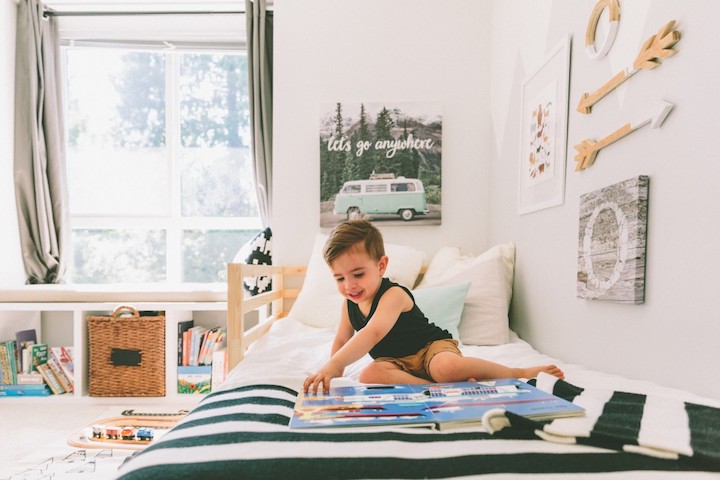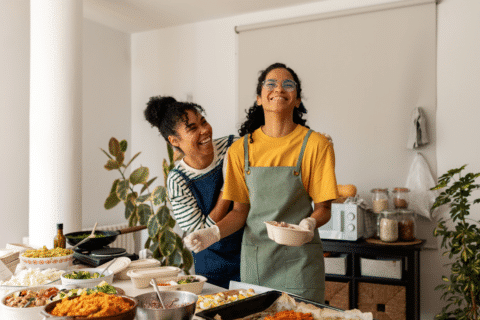Parenting style pop quiz: How does rolling up your sleeves and painting a pumpkin bright teal with your kids sound to you? If it sounds great, you are Crafty Activist Parent. If it sounds awful, no worries. You can be Involved Tidy Parent (more on how in a bit).
Either way, you can participate in the Teal Pumpkin Project, help raise awareness about food allergies, and ensure that all kids have a safe and fun-filled Halloween. My family participated for the first time last year when my oldest was two and my youngest was just three months old. Although we didn’t have food allergies in our family – yet – my breastfed infant was sensitive to dairy in my diet, making milk chocolate a no-go for me.
A year later, my infant has outgrown her dairy intolerance, but we’ve recently learned that she’s allergic to peanuts and tree nuts. Her diagnosis is difficult, for sure, but we’re coping in part by helping other families learn about participating in the Teal Pumpkin Project.

What is the Teal Pumpkin Project?
I first learned about the Teal Pumpkin Project through my work as a family health dietitian. Becky Basalone, mom to two boys with allergies and intolerances, started the Teal Pumpkin project in 2012 as a way to promote Halloween-season allergy awareness in her own community. The nonprofit organization FARE (Food Allergy Research and Education) adopted the project in 2014 and now provides free resources to anyone willing to participate.
Participating is simple – just stock up on some non-food treats, announce your participation by displaying either a DIY teal pumpkin, a store-bought one (most big box stores have options) or even just a printed sign, and add your address to FARE’s Teal Pumpkin Project Map.
“My kids don’t have allergies”
If your own children don’t have food allergies, why participate? In a nutshell, to support your community. Just think about the joy your non-allergic kids get from Halloween. They plan their costumes months in advance, eagerly engage in school parties and neighborhood trick-or-treating, gorge on candy and strategically swap items from their stashes.
If the thought of all that candy stresses you out a little, think about families with food allergies where every occasion involving shared food is a source of stress. Even if every allergy family participated (currently one out of thirteen kids), food-allergic kids would only be able to confidently trick-or-treat at less than ten percent of their neighbors’ homes. Why not pay your family’s good health forward and help families with food allergies fully enjoy the holiday, too?
An allergy-free Halloween is fun for the other kids, too
You may wonder if kids actually like non-food treats, especially when the alternative is candy. I promise, they do! Think about your child’s excitement when plundering the goodie bag from a birthday party. Treats are great, of course, and they’ll always play an important role in Halloween, but trinkets last longer and won’t be sequestered by mom and dad after the initial candy binge. Handing out allergy-friendly candy is an option, too, although FARE highly encourages having a non-food option handy.
The best allergy-free treat ideas for Halloween
Non-food treats: The sky is the limit! Try glow sticks and bracelets, temporary tattoos, stickers, spider rings, erasers, bubbles, money (really!) or any number of novelty toys like whistles and maze puzzles.
Candy free from common allergens: Be mindful that some families may still decline these options due to concerns about cross-contamination or sensitivities to food dyes. That said, lollipops and gummy candies tend to be free of common allergens.
Dried fruit: If you must pass out healthy food (some schools request it) options include individual packages of prunes, plain raisins or dried cranberries, or snack bags of freeze-dried fruit. Note that this category is pretty much limited to dried fruit, which may still be a no-go for anyone with a specific fruit allergy or oral allergy syndrome.

Making the holiday fun, safe … and maybe a little sugary
At my house this year, we’ll be handing out fun tattoos and my personal favorite candy, Sour Patch Kids. I know, I know, I’m a dietitian. Shouldn’t I be skipping the candy altogether? Actually, I strongly believe that sugary treats play a major role in the overall healthy diet of every kid. Allowing treats in moderation throughout the year – and even in potentially uncomfortable amounts on holidays like Halloween – helps children to feel relaxed around these foods and recognize their role in celebrations as well as daily life. This strategy has already been working well with my older daughter, who often leaves her treats half-eaten when she’s full or when a more interesting opportunity to play presents itself. Of course, I want my younger daughter to adopt this attitude, too, so that means incorporating safe treats into our day-to-day life and celebrations.
I also want my children to enjoy childhood to the fullest extent possible, including normal experiences like trick-or-treating. For that, I need the help of other parents. My allergic daughter may always need an alternative safe treat that I provide at birthday parties and the like, but because of the Teal Pumpkin Project, I know Halloween won’t be any less fun for her just because of her allergies. I hope you’ll choose to participate!
Diana K. Rice, RD, LD, is known as The Baby Steps Dietitian and is the founder of Diana K. Rice Nutrition, LLC, where she works with families to eat well and reduce the stress surrounding their food choices. She specializes in pre- and postnatal nutrition as well as feeding young children and is a strong advocate for cooking with kids, family meals, and body positivity. Her expertise has been featured in Fit Pregnancy, Parents, U.S. News and World Report, Today’s Dietitian, and many other publications. Follow her blog at dianakrice.com and connect with her on Facebook and Instagram.






